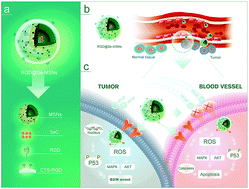A highly selective dual-therapeutic nanosystem for simultaneous anticancer and antiangiogenesis therapy†
Abstract
The rational design of highly selective and cancer-targeted nanodrug delivery systems with attractive anticancer activities is urgently needed for future exploration and translational application of nanomedicine. As angiogenesis and tumor growth could be mutually enhanced, dual therapeutic nanomedicine with simultaneous antiangiogenesis and anticancer activities is practical for cancer therapy. Therefore, herein we have rationally designed functionalized mesoporous silica nanoparticles (MSNs) to realize the dual therapy of tumor growth and angiogenesis based on the biochemical similarity of membranes of cancer cells and angiogenic cells. This nanosystem demonstrates high selectivity in vivo against cancer cells with high integrin expression levels in two-tumor bearing models, and could simultaneously inhibit cancer cell growth and disrupt tumor neovasculature, thus achieving satisfactory in vivo anticancer efficacy. Interestingly, the nanosystem triggers ROS overproduction in both cancer and human umbilical vein endothelial cells, which activates various downstream signaling pathways to regulate cell cycle arrest and apoptosis. Moreover, the nanosystem also effectively reduces the toxic side effects of loaded drugs to normal tissues and prolongs blood circulation in vivo. Therefore, this study provides a simple approach for facile manufacture of a potent nanodrug delivery system that could achieve dual therapy of tumor growth and angiogenesis.



 Please wait while we load your content...
Please wait while we load your content...